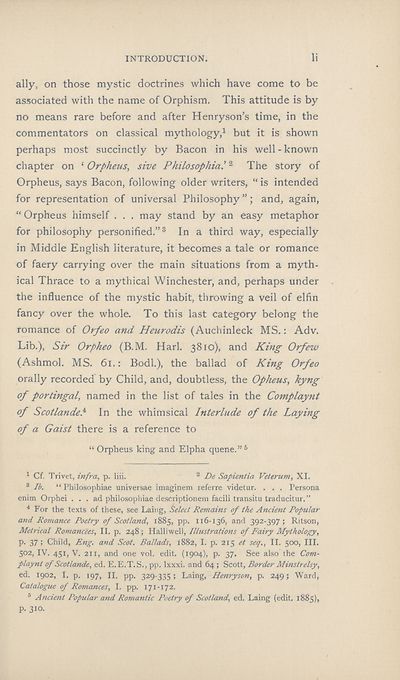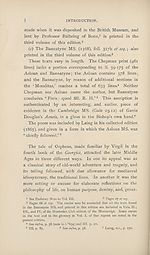Download files
Complete book:
Individual page:
Thumbnail gallery: Grid view | List view

INTRODUCTION.
li
ally, on those mystic doctrines which have come to be
associated with the name of Orphism. This attitude is by
no means rare before and after Henryson’s time, in the
commentators on classical mythology,1 but it is shown
perhaps most succinctly by Bacon in his well-known
chapter on ‘ Orpheus, sive Philosophia.’2 The story of
Orpheus, says Bacon, following older writers, “ is intended
for representation of universal Philosophy”; and, again,
“ Orpheus himself . . . may stand by an easy metaphor
for philosophy personified.”3 In a third way, especially
in Middle English literature, it becomes a tale or romance
of faery carrying over the main situations from a myth¬
ical Thrace to a mythical Winchester, and, perhaps under
the influence of the mystic habit, throwing a veil of elfin
fancy over the whole. To this last category belong the
romance of Orfeo and Heurodis (Auchinleck MS.: Adv.
Lib.), Sir Orpheo (B.M. Harl. 3810), and King Orfew
(Ashmol. MS. 61.: Bodl.), the ballad of King Orfeo
orally recorded by Child, and, doubtless, the Opheus, kyng
of portingal, named in the list of tales in the Complaynt
of ScotlandeP In the whimsical Interlude of the Laying
of a Gaist there is a reference to
“ Orpheus king and Elpha quene.” 5
1 Cf. Trivet, infra, p. liii. 2 De Sapientia Velerum, XI.
3 lb. “ Philosophiae universae imaginem referre videtur. . . . Persona
enim Orphei ... ad philosophiae descriptionem facili transitu traducitur.”
4 For the texts of these, see Laing, Select Remains of the Ancient Popular
and Romance Poetry of Scotland, 1885, pp. 116-136, and 392-397; Ritson,
Metrical Romaneses, II. p. 248; Halliwell, Illustrations of Fairy Mythology,
p. 37 ; Child, Eng. and Scot. Ballads, 1882, I. p. 215 et seq., II. 500, III.
502, IV. 451, V. 211, and one vol. edit. (1904), p. 37. See also the Com¬
playnt of Scotlande, ed. E.E.T. S., pp. Ixxxi. and 64 ; Scott, Border Minstrelsy,
ed. 1902, I. p. 197, II. pp. 329-335; Laing, Henryson, p. 249; Ward,
Catalogue of Romances, I. pp. 171-172.
5 Ancient Popular and Romantic Poetry of Scotland, ed. Laing (edit. 1885),
p. 310.
li
ally, on those mystic doctrines which have come to be
associated with the name of Orphism. This attitude is by
no means rare before and after Henryson’s time, in the
commentators on classical mythology,1 but it is shown
perhaps most succinctly by Bacon in his well-known
chapter on ‘ Orpheus, sive Philosophia.’2 The story of
Orpheus, says Bacon, following older writers, “ is intended
for representation of universal Philosophy”; and, again,
“ Orpheus himself . . . may stand by an easy metaphor
for philosophy personified.”3 In a third way, especially
in Middle English literature, it becomes a tale or romance
of faery carrying over the main situations from a myth¬
ical Thrace to a mythical Winchester, and, perhaps under
the influence of the mystic habit, throwing a veil of elfin
fancy over the whole. To this last category belong the
romance of Orfeo and Heurodis (Auchinleck MS.: Adv.
Lib.), Sir Orpheo (B.M. Harl. 3810), and King Orfew
(Ashmol. MS. 61.: Bodl.), the ballad of King Orfeo
orally recorded by Child, and, doubtless, the Opheus, kyng
of portingal, named in the list of tales in the Complaynt
of ScotlandeP In the whimsical Interlude of the Laying
of a Gaist there is a reference to
“ Orpheus king and Elpha quene.” 5
1 Cf. Trivet, infra, p. liii. 2 De Sapientia Velerum, XI.
3 lb. “ Philosophiae universae imaginem referre videtur. . . . Persona
enim Orphei ... ad philosophiae descriptionem facili transitu traducitur.”
4 For the texts of these, see Laing, Select Remains of the Ancient Popular
and Romance Poetry of Scotland, 1885, pp. 116-136, and 392-397; Ritson,
Metrical Romaneses, II. p. 248; Halliwell, Illustrations of Fairy Mythology,
p. 37 ; Child, Eng. and Scot. Ballads, 1882, I. p. 215 et seq., II. 500, III.
502, IV. 451, V. 211, and one vol. edit. (1904), p. 37. See also the Com¬
playnt of Scotlande, ed. E.E.T. S., pp. Ixxxi. and 64 ; Scott, Border Minstrelsy,
ed. 1902, I. p. 197, II. pp. 329-335; Laing, Henryson, p. 249; Ward,
Catalogue of Romances, I. pp. 171-172.
5 Ancient Popular and Romantic Poetry of Scotland, ed. Laing (edit. 1885),
p. 310.
Set display mode to: Large image | Zoom image | Transcription
Images and transcriptions on this page, including medium image downloads, may be used under the Creative Commons Attribution 4.0 International Licence unless otherwise stated. ![]()
| Publications by Scottish clubs > Scottish Text Society publications > Old series > Poems of Robert Henryson > Volume 1, 1914 > (61) |
|---|
| Permanent URL | https://digital.nls.uk/107410907 |
|---|
| Shelfmark | SCS.STES1.64 |
|---|---|
| Attribution and copyright: |
|
| Description | Edited by G. Gregory Smith. |
|---|---|
| Shelfmark | SCS.STES1.64 and SCS.STES1.55 |
| Additional NLS resources: | |
| Description | A collection of over 100 Scottish texts dating from around 1400 to 1700. Most titles are in Scots, and include editions of poetry, drama, and prose by major Scottish writers such as John Barbour, William Dunbar, Gavin Douglas, and George Buchanan. Edited by a key scholarly publisher of Scotland's literary history, and published from the late 19th century onwards by the Scottish Text Society. Available here are STS series 1-3. |
|---|

